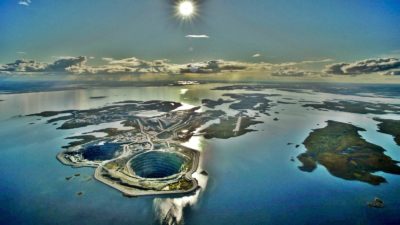
I read an interesting article in the Mining Magazine May 2015 edition called “Top 10 Technologies”. One of the new technologies that jumped out at me is the capability to directionally drill open pit dewatering wells. This is an oil field technology from Schlumberger Water Services that was now going to be applied to mining.
 One of my past roles was as a mine engineer on the Diavik diamond mine team. Pit geotechnical and hydrogeology were under my domain during project design and permitting from 1997 to 2000.
One of my past roles was as a mine engineer on the Diavik diamond mine team. Pit geotechnical and hydrogeology were under my domain during project design and permitting from 1997 to 2000.
The granitic rock mass was geotechnically very competent with a limited amount of jointing and fracturing. The pits were going to be located within a lake bed.
It was anticipated that groundwater seepage coming from a partly permafrost pit wall could create a host of operational problems in winter. Most of the groundwater flows were predicted to be along a few major structures or along single open joints.
Generally these major structures were near vertical, which created a problem when trying to intercept them with vertically drilled depressurization wells. Either you hit one or you didn’t.
The use of directional drilling of pumping wells is a great innovation


 The bottom line is that the directional drilling innovation makes a lot of sense and mine operators should take a look at it. It might help improve their pit dewatering systems.
The bottom line is that the directional drilling innovation makes a lot of sense and mine operators should take a look at it. It might help improve their pit dewatering systems.
Can you explain a bit more about what your engineering roles were while working in Diavik. And how directional drilling was involved and the procedure of it.
With Diavik, I was part of the original design team in 1997 to 2000 and my role was geotechnical, hydrogeology, and eventually mine planning. I learned about the directional well drilling technique in 2015, many years after I left Diavik. However such drilling may have been a useful tool to intercept the near vertical water bearing structures. This blog has a bit more info. http://kuchling.com/59-hydrogeology-at-diavik-its-complicated/
I’m glad that you talked that using a vertical process for structures could provide an effective dewatering method. My uncle mentioned to me the other day that he and his business partner were hoping to find dewatering pumps servicing for an effective dewatering process for their residential site preparation. He asked if I had any idea what would be the best option to consider. Thanks to this informative pump article, I’ll tell him that it will be much better if they consult a dewatering pump company as they can provide information about the best process.
Interesting article, thanks for the insite